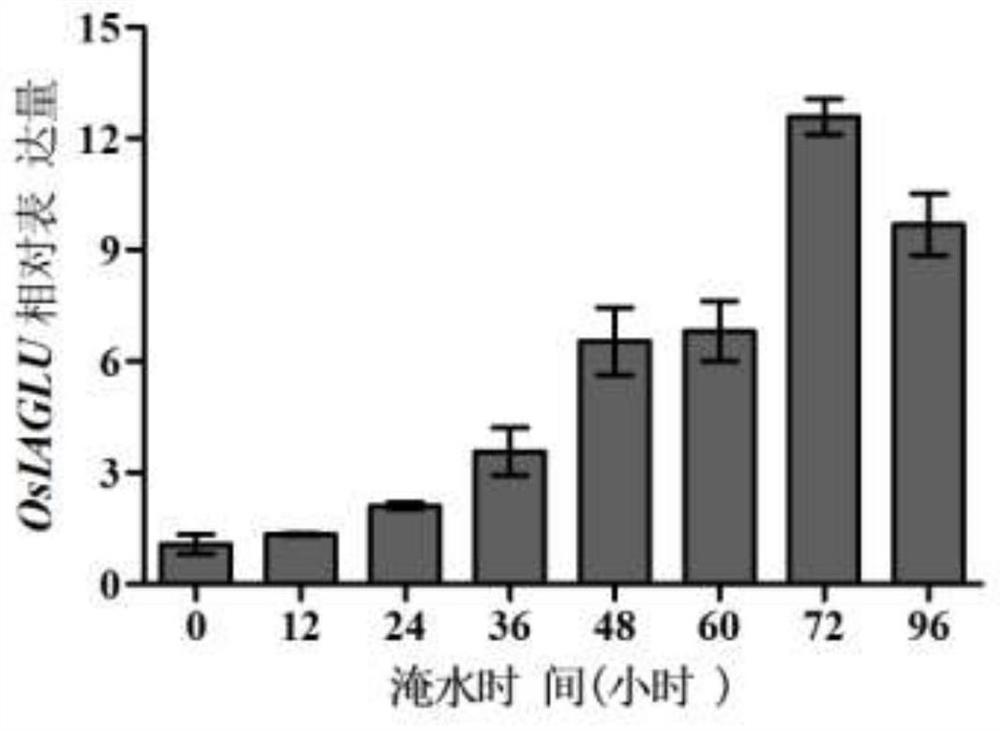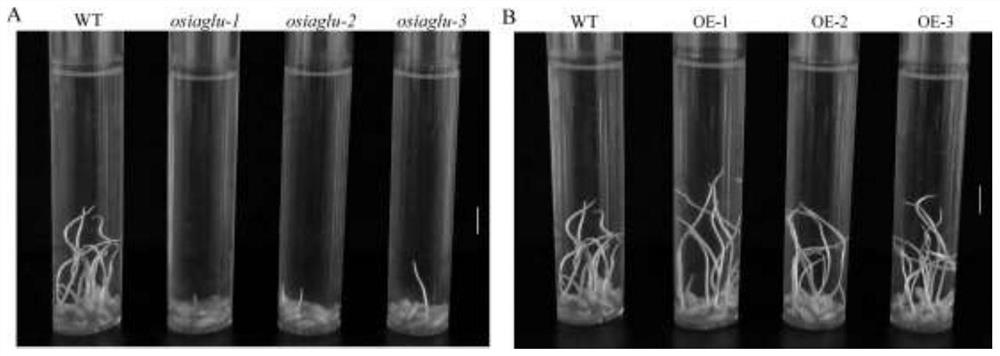Application of rice auxin glycosyltransferase gene in cultivation of flooding-resistant rice varieties
A technology of glycosyltransferase and auxin, applied in application, genetic engineering, plant genetic improvement and other directions, can solve the problems of reducing seed germination rate, affecting crop yield, poor seedling formation in the field, etc.
- Summary
- Abstract
- Description
- Claims
- Application Information
AI Technical Summary
Problems solved by technology
Method used
Image
Examples
Embodiment 1
[0045] Example 1: Gene Cloning
[0046] The sequence of the OsIAGLU gene was cloned by PCR using the japonica rice variety Nipponbare cDNA as a template. The upstream primer sequence of PCR is shown in SEQ ID NO.3 in the sequence table, and the downstream primer sequence is shown in SEQ ID NO.4 in the sequence table. The nucleotide sequence and amino acid sequence of the rice OsIAGLU gene are obtained, the nucleotide sequence is shown in SEQ ID NO.1 in the sequence table, and the amino acid sequence is shown in SEQ ID NO.2.
Embodiment 2
[0047] Example 2: Analysis of OsIAGLU gene expression at different times of seed flooding
[0048]Using the japonica rice variety Nipponbare, select 15 healthy and full seeds each time, disinfect the surface with 0.1% mercuric chloride solution for 5 minutes, rinse with distilled water for 3 times, dry the surface of the seeds, put them in a test tube, add 8 cm deep distilled water, They were cultured at 25°C under light / dark conditions for 12 hours each, and samples were taken after flooding for 0, 12, 24, 36, 48, 60, 72, and 96 hours. The seeds were frozen in liquid nitrogen and quickly ground into powder, and the samples were stored at -80°C. The experiment was repeated 3 times.
[0049] Use the TransZol Plant kit (Transgen, www.transgen.com) kit to extract the RNA of each sample; II Reverse Transcriptase system (Vazyme Biotech Co., Ltd) kit was reverse-transcribed to form cDNA, which was used as a template; analyzed with fluorescent quantitative PCR, and fluorescent qu...
Embodiment 3
[0050] Example 3: Mutant construction
[0051] login to website http: / / www.genome.arizona.edu / crispr / CRISPRsearch.html , screening targets. The target sequence is shown in the sequence list SEQ ID NO.5, SEQ ID NO.6, and primers are designed based on the target sequence, and the primer structure is shown in the sequence list SEQ ID NO.7, SEQ ID NO.8, SEQ ID NO.9, SEQ ID NO.10. Using pCBC-MT1T2 as a template, PCR amplification with four primers was carried out, and the PCR product was purified and recovered to obtain MT1T2-PCR vector. The pHUE411 vector was digested with BsaI, and the MT1T2-PCR gel recovery product was constructed on the pHUE411 vector by homologous recombination to obtain the pHUE411+MT1T2-PCR vector.
[0052] The obtained plasmid containing the pHUE411+MT1T2-PCR vector was transformed into Agrobacterium; the Agrobacterium with the transformed plasmid was transformed into the wild-type japonica rice variety Nipponbare; the PCR amplification product was sequ...
PUM
 Login to View More
Login to View More Abstract
Description
Claims
Application Information
 Login to View More
Login to View More - R&D Engineer
- R&D Manager
- IP Professional
- Industry Leading Data Capabilities
- Powerful AI technology
- Patent DNA Extraction
Browse by: Latest US Patents, China's latest patents, Technical Efficacy Thesaurus, Application Domain, Technology Topic, Popular Technical Reports.
© 2024 PatSnap. All rights reserved.Legal|Privacy policy|Modern Slavery Act Transparency Statement|Sitemap|About US| Contact US: help@patsnap.com









